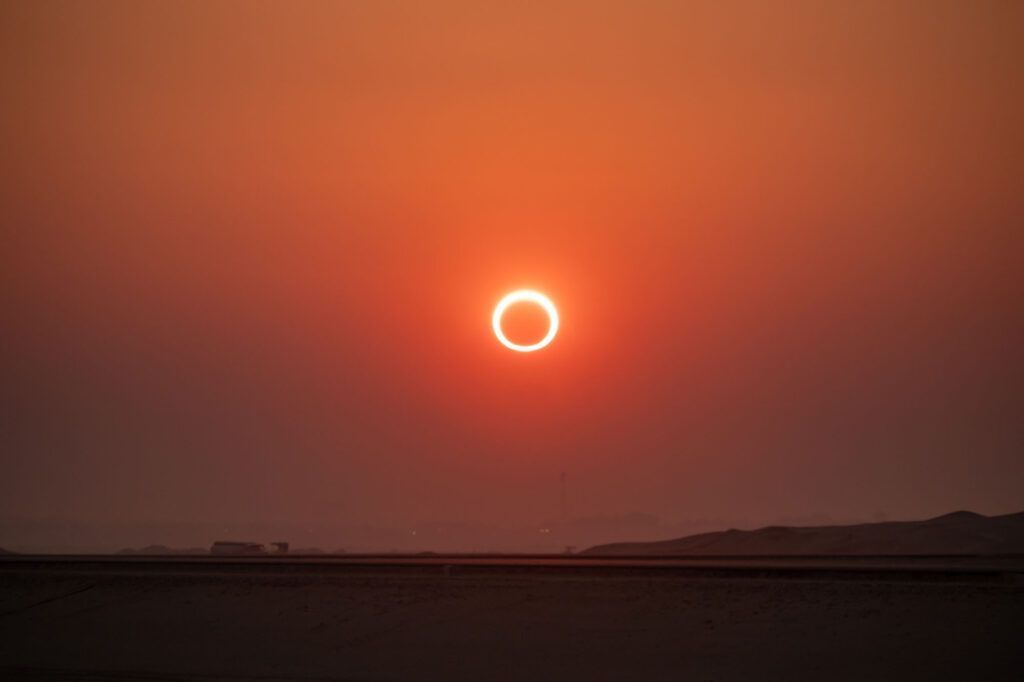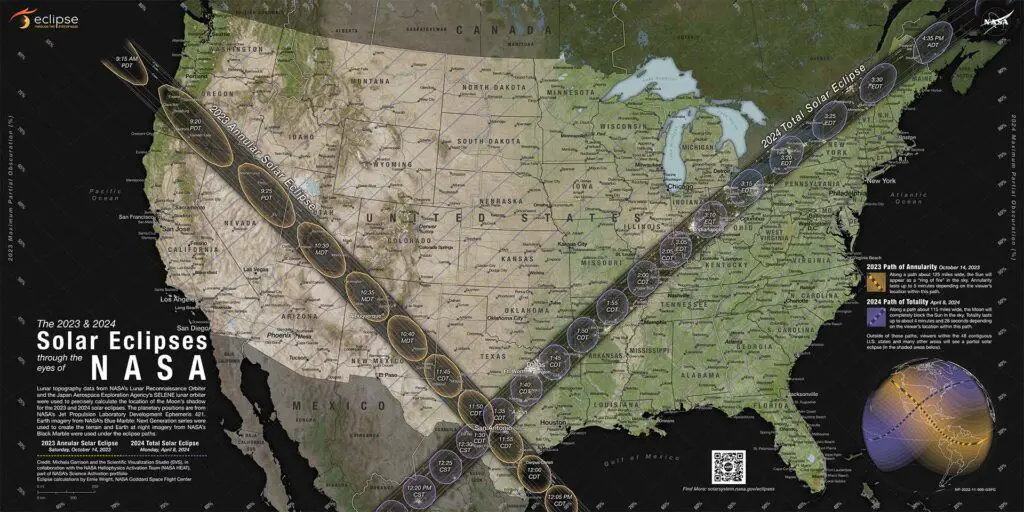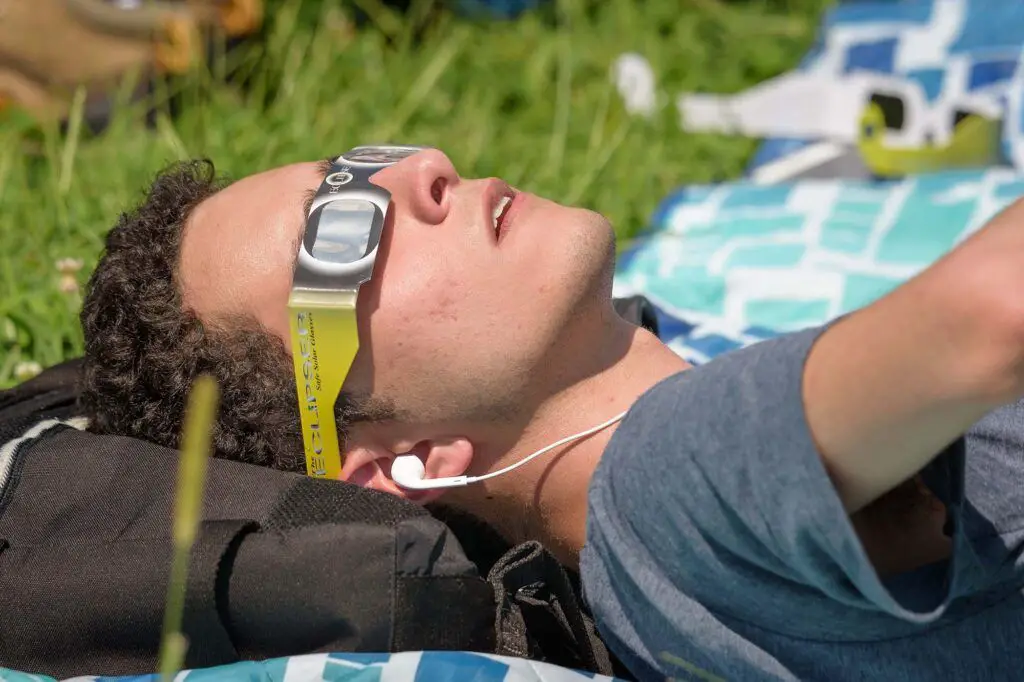If you’re a stargazer and on the West Coast, you’re in for a treat on October 14. An annular solar eclipse, one of the most enchanting celestial events, is set to grace the sky. Unlike a total eclipse, where the moon completely covers the sun, an annular eclipse leaves a ring-like appearance, often referred to as the “ring of fire.”

What Is an Annular Solar Eclipse?
An annular solar eclipse occurs when the moon’s size appears smaller than the sun’s, blocking most of the sun’s light, but not completely blocking it out. This causes the sun to look like a ring like the picture above. This is due to the eclipse occurring when the moon is farther away from Earth in its elliptical orbit. But what causes this particular phenomenon?
Annular solar eclipse vs total eclipse
During a solar eclipse, the moon passes between the Earth and the sun, momentarily blocking the sun’s light. In an annular eclipse, the moon is near its apogee, the farthest point from the Earth in its elliptical orbit. Because of this increased distance, the moon appears slightly smaller in the sky, unable to cover the entire sun as a total eclipse would.
The Ring of Fire and the Path of Annularity
The “ring of fire” is the defining characteristic of an annular eclipse. This thin, bright ring is actually the sun’s outer edge, or photosphere, still visible around the moon’s dark disk. Since the moon is not large enough to cover the sun entirely, the sun’s outer rim creates this dazzling effect, producing an ethereal glow that is breathtaking to behold. Because the moon does not completely cover the brightest part of the sun, there is no darkness.
At annularity, the sky takes on a more reddish hue akin to a sunrise or sunset. It is very important that you wear protective eyewear at all times, even within the “path of annularity.” This narrow path is where the ring of fire is visible. Outside this path, viewers will see a partial eclipse.
Where and When to See the 2023 Annular Solar Eclipse
While this particular annular eclipse may not be visible across the entire United States, portions of the western and southwestern states will be treated to varying degrees of the spectacle. The path of annularity (where the “ring of fire” will be visible) will be passing through parts of Oregon, Nevada, Utah, New Mexico, and Texas.
In the U.S., the annular solar eclipse begins in Oregon at 12:13 pm EDT (9:13 am PDT) and ends in Texas at 1:03 pm EDT (12:03 pm CDT).

The timing will vary depending on your location, so be sure to consult a local astronomical organization or online tools to determine the exact times for your area. However, in general, the eclipse will be occurring in the early morning hours, local time. Here’s a general guide for timing along the path of annularity:
| Location | Partial Eclipse Begins | Annularity Begins | Maximum | Annularity Ends | Partial Eclipse Ends |
|---|---|---|---|---|---|
| Eugene, Oregon | 8:06 a.m. PDT | 9:16 a.m. PDT | 9:18 a.m. PDT | 9:20 a.m. PDT | 10:39 a.m. PDT |
| Alturas, California | 8:05 a.m. PDT | 9:19 a.m. PDT | 9:20 a.m. PDT | 9:21 a.m. PDT | 10:43 a.m. PDT |
| Battle Mountain, Nevada | 8:06 a.m. PDT | 9:21 a.m. PDT | 9:23 a.m. PDT | 9:25 a.m. PDT | 10:48 a.m. PDT |
| Richfield, Utah | 9:09 a.m. MDT | 10:26 a.m. MDT | 10:28 a.m. MDT | 10:31 a.m. MDT | 11:56 a.m. MDT |
| Albuquerque, New Mexico | 9:13 a.m. MDT | 10:34 a.m. MDT | 10:35 a.m. MDT | 10:39 a.m. MDT | 12:09 p.m. MDT |
| San Antonio, Texas | 10:23 a.m. CDT | 11:52 a.m. CDT | 11:54 a.m. CDT | 11:56 a.m. CDT | 1:33 p.m. CDT |
How to Safely Observe the Eclipse
Safety is paramount when observing a solar eclipse. Looking directly at the sun without proper protection can cause serious and permanent eye damage. And unlike a total solar eclipse, you must wear protective eyewear for the entire event, even if you’re within the path of annularity. Here are some ways to safely observe the event:
- Solar Viewing Glasses: These special glasses are designed specifically for looking at the sun and can be purchased from reputable vendors.
- Pinhole Projector: You can make a simple pinhole projector using a piece of paper and a pin. Punch a small hole in the paper and let the sunlight shine through onto a flat surface. You’ll see a small, inverted image of the sun as it goes through the stages of the eclipse.
- Telescopes with Solar Filters: If you have access to a telescope, ensure it is equipped with a proper solar filter. Many astronomical societies might be hosting viewing parties with properly equipped telescopes.

Is there a total solar eclipse in 2023?
No, not in North America at least. However, there is a total solar eclipse in 2024 that will offer more than two-thirds of Americans to witness the sun more than 50% eclipsed (with a path of totality from Texas to the Great Lakes). That one will have the best views in the central and eastern parts of the country.
Wrapping Up
The October annular solar eclipse offers a rare opportunity to witness one of nature’s most mesmerizing spectacles. Whether you’re an amateur astronomer, a student of the cosmos, or just someone who appreciates the beauty of the sky, make sure to mark the date and prepare to enjoy the event safely.
Remember, whether you’re on the path of annularity or elsewhere in the U.S., there are still ways to enjoy this celestial event. Many local observatories and online platforms will likely provide live coverage, allowing everyone a chance to witness the stunning “ring of fire.” We’ll continue to update this article as the event comes closer.


